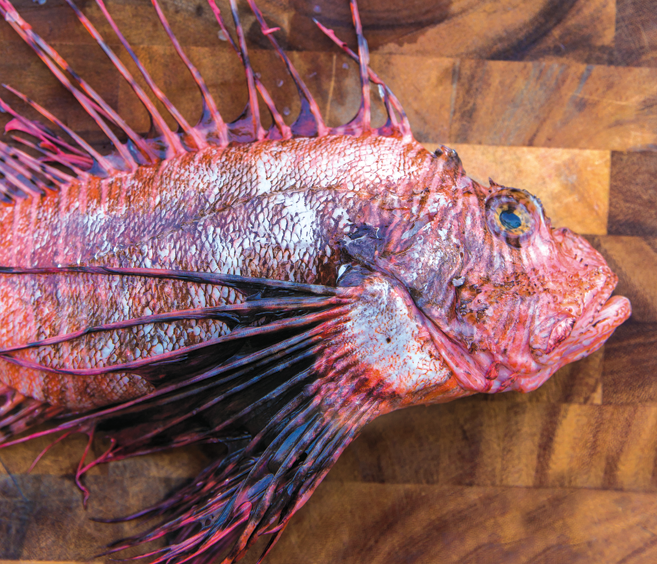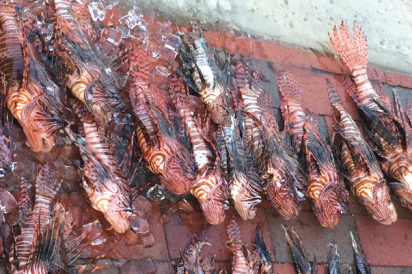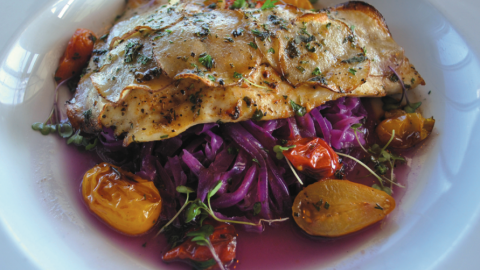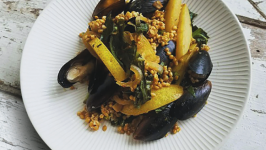The Lionfish Tamers
The alien invader hovers. It has no natural predators, and is unconcerned as the diver approaches. It is voracious and nearly unstoppable. And it is delicious.
The lionfish, native to the Indo-Pacific waters, was spotted in Florida in the 1980s. What started as just a few fish, multiplied by millions and spread in currents. In South Carolina, lionfish are devouring our local reef-dwellers.
South Carolina Aquarium senior biologist/dive safety officer Arnold Postell has the fish on a kind of aquatic “most wanted” list. He’s doing his best to reduce lionfish numbers, but the battle is daunting. Local sea creatures that tried to prey on the strikingly beautiful fish have choked to death on the venomous spines that form the “mane” that gives the fish its name.
“They’re prolific breeders,” Postell says, adding that every four days, they lay 10,000 to 20,000 eggs.
The only hope is to reduce the lionfish numbers by creating a market for the delicious creature. That’s where Fleet Landing’s chef Drew Hedlund comes in.
After graduating from Charleston’s Johnson & Wales University, the Florida native worked in a few restaurants, including Slightly North of Broad with Frank Lee and 101 Pitt in Mount Pleasant. The chef there invited him to take the job at Fleet Landing.
“After four months, he approached me and asked, ‘You ready to be executive chef?’ I said yes…and the rest is history.”
Fleet Landing was invited to participate in the aquarium’s Good Catch Program. Hedlund was confident that he would ace the menu assessment.
“As a chef, I thought I knew everything,” Hedlund says now, adding that he was stunned when the report came back pointing out all the ways his menu fell short of sustainable.
With guidance from the aquarium, Hedlund led Fleet Landing to become a Good Catch platinum partner, the highest rating. Along the way, he was enlisted to add lionfish to Fleet Landing’s menu.
“If you can get restaurants to serve it, they would be serving sustainable animals with an almost unlimited supply,” Postell says.
The fish aren’t hard to catch (“They just float there looking at you,” Postell says) but their venomous spines can make them tricky for divers, who use a spear gun and then toss the fish in something like a PVC pipe so they don’t get stung.
“About half of their fins have what’s like a hypodermic needle that releases venom,” Postell says. “It’s an incredibly painful sting. It’s not fatal, but it’s going to hurt a lot.”
In South Carolina the fish congregate in deeper, warmer waters and South Carolina and divers are limited by how long they can stay at those depths. Even the lionfish fillets sold in Mount Pleasant’s Whole Foods come from Florida, where the grocer has sold more than 25,000 pounds since it started offering lionfish in April 2016.
Hedlund had been getting his fish from the now-defunct Kenyon Seafood of Murrell’s Inlet and had to build up to offering it on the menu.
“Fishermen are kind of funny. We created the relationship first and then they would tell me they shot 50 pounds of lionfish and I’d say, ‘I’ll take all of those’,” Hedlund recalls. “Then they’d say, ‘We got 60 pounds,’ and I’d take all of those. After a couple of years, they were bringing in 300 to 400 pounds and I would take all of them.”
The spiny fish yields only about half its weight in meat, and Hedlund says the 300 pounds would last only three or four days because of the fish’s popularity.
Although lionfish are on the menu year-round, there are fewer in the winter, for a very good reason. “We have a pretty prodigious shark population, so the spear fishermen don’t really fish much in winter because food’s a little harder to find and the sharks are hungry. Ascending 120 feet with a bunch of dead, bleeding fish on your back, you know, sharks kind of smell that stuff,” Hedlund jokes.
He serves lionfish pan-seared, oven-roasted and, his favorite, whole, scored and flash-fried.
“I think they are delicious. The ‘white flaky and mild’ stereotype, is overused, but that’s what it is. I want to say it’s a bit more buttery than flounder, they are thin fillets, so they’re similar to flounder. But they have this brilliant, almost china-like white flesh to it.”
People see lionfish come out and they want to know what it is. It’s beautiful. It’s dramatic,” Hedlund says. “And when we can tell the guests what boat it came off, the captain’s name, and how it is impacts the environment, it really resonates with them.”











